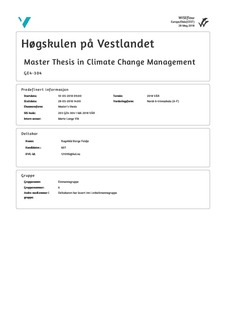| dc.contributor.author | Feidje, Ragnhild Berge | |
| dc.date.accessioned | 2018-08-15T09:18:44Z | |
| dc.date.available | 2018-08-15T09:18:44Z | |
| dc.date.issued | 2018-05 | |
| dc.identifier.uri | http://hdl.handle.net/11250/2558098 | |
| dc.description | Masteroppgåve i Climate Change Management (Planlegging for klimaendringar) Institutt for miljø- og naturvitskap, Fakultet for ingeniør- og naturvitskap GE4-304 | nb_NO |
| dc.description.abstract | Det er viktig å tilpasse seg eit klima i endring. Denne tilpassinga vil i stor grad skje på lokalt nivå, då det er her ein merkar effektane. Målet med denne oppgåva er å auke kunnskapen om korleis kommunar i Sogn og Fjordane arbeider med klimatilpassing og kva utfordringar dei har knytt til dette. Studien vil sjå nærare på to ting:
1) Kva som står fram som hinder for førebyggande eller proaktiv klimatilpassing
2) Kva utfordringar kommunane har i dag. For sist nemnte blir det tatt utgangspunkt i og samanlikna med utfordringane kunnskapsgrunnlaget, kompetanse og kapasitet, nasjonal styring, prioritering og ressursar og samspel mellom sektorar og forvaltingsnivå, som blei avdekka i Noregs offentlege utgreiing med tittelen Tilpassing til eit klima i endring i 2010.
I denne studien er det gjennomgått kommunale planar, og i tillegg intervju med tilsette i dei respektive kommunane som jobbar med klimatilpassing. Desse kommunane er Aurland, Førde, Gloppen og Sogndal
Hovudfunna i studien er at kommunane ønskjer å vere proaktive. Likevel er arbeidet med klimatilpassing i stor grad reaktivt. I den grad det blir gjort proaktiv tilpassing er det som del av arealplanlegging, og forankra i lover kommunane må følge ved utbygging av nye områder. I tillegg er dei utfordringane kommunane vurderer til å bli størst i framtida, spegla av allereie opplevde klimahendingar.
I samanlikninga med utfordringar frå NOU:10 2010 finn ein at kunnskapsgrunnlaget og kompetansen har auka. Klimatilpassing verkar å ha ein høgare prioritet i kommunane no. Manglande nasjonale føringar, kapasitet og ressursar er framleis store utfordringar for kommunane. Samspel på tvers av forvaltningsnivå, interkommunalt og innad i kommunane er varierande, og for ei utfordring.
Utfordringane kommunane har no går i stor grad på å greie å prioritere klimatilpassing utover det som er sikring og førebygging mot naturfarar. Det blir i lita grad tatt omsyn til t.d. biologisk mangfald, sårbare artar, endringar i vekstsesong, nye sjukdommar og havforsuring. | nb_NO |
| dc.description.abstract | Abstract:
Adaptation to climate change is important, and it will largely happen at a local level, as this is where the changes will be most noticeable.
The aim of this study is to increase knowledge regarding climate change adaptation in municipalities in Sogn og Fjordane county. The study will look at how the municipalities work with climate change adaptation, and challenges that occur. More narrowly, the study will look into two aspects:
1) What are the barriers to proactive adaptation.
2) What challenges do the municipalities face today. This aspect is based on the challenges: knowledgebase, competence and capacity, national governance, prioritization and resources, and cross-sectoral cooperation found in NOU:10 2010, a green paper on adaptation in a changing climate.
For this study, municipal plans and interviews with municipal officials form the foundation of the empirical material. The case-municipalities for this study are Aurland, Førde, Gloppen and Sogndal.
The main findings of this study, is that the municipalities wish to be proactive as they adapt to climate change. Still, most of the work is done reactively. To the extend, proactive adaptation is done, and it is through land-use planning, embedded in laws and the regulations the municipalities are required to follow. In addition, the leading challenges the municipalities face in the future, are a reflection of climate related events already experienced within the municipality.
When comparing the challenges from NOU:10 2010, and the ones uncovered in this study, a few findings stand out. The knowledge base and the competence has increased. Climate adaptation seem to have higher priority today. Lack of national governance, capacity and resources are yet a great challenge. Cross- sectoral and multi-level cooperation varies and is still a challenge today.
One of the key challenges facing the municipalities working with climate adaptation today, is to be able to prioritize a broader range of climate adaptation measures. This means to also focus on e.g ., biodiversity, endangered species, changes in growth season, new diseases and ocean acidification, not just natural hazards and civil protection. | nb_NO |
| dc.language.iso | nno | nb_NO |
| dc.publisher | Høgskulen på Vestlandet | nb_NO |
| dc.rights | Navngivelse 4.0 Internasjonal | * |
| dc.rights.uri | http://creativecommons.org/licenses/by/4.0/deed.no | * |
| dc.subject | klimatilpassing | nb_NO |
| dc.subject | proaktiv klimatilpassing | nb_NO |
| dc.subject | kommunar | nb_NO |
| dc.subject | klimatilpassing i Sogn og Fjordane | nb_NO |
| dc.subject | utfordringar | nb_NO |
| dc.title | Klimatilpassing i kommunar i Sogn og Fjordane | nb_NO |
| dc.type | Master thesis | nb_NO |
| dc.description.localcode | GE4-304 | nb_NO |

